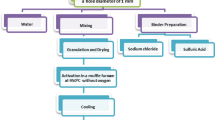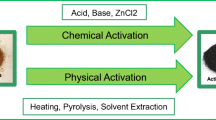Abstract
A study was undertaken to investigate the liberation behavior of coal macerals through size reduction and density separation. It was seen that the liberation of coal macerals could be achieved by size reduction, allowing selective separation of coal organic components. However, the degree of liberation was dependent upon the comminution history. Even for the same fineness, the extent of liberation might not be the same depending on how the material was generated. The liberation of coal macerals was analyzed by examining the liberation index. It was seen that, although comminution produced fine particles enriched in inertinite (primarily fusinite and semifusinite), these particles were less liberated than coarser particles. However, the liberation of macerals increased when all the feed was ground to a finer size.
Similar content being viewed by others
References
Austin, L.G., 1994, “Patterns of liberation of ash from coal,” Minerals and Metallurgical Processing, Vol. 11, No. 3, pp. 148–149
Bowen, R.M., and Jowett, A., 1986, “Coal cleaning calculations based on alternatives to standard washability curves,” Fuel, Vol. 65, pp. 28–33.
Dell, C.C., 1964, “An improved release analysis procedure for determining coal washability,” J. Inst. Fuel, Vol. 37, pp. 149–150.
Dell, C.C., 1969, “An expression for the degree of liberation of an ore,” Trans. Inst. Min. Met., Vol. 78, pp. 152–153.
Dumm, T., 1986, “An Evaluation of Techniques for Characterization of Respirable Dust,” M.S. Thesis, The Pennsylvania State University, University Park, PA.
Dyrkacz, G.R., and Horwitz, E.P., 1982, “Separation of coal macerals,” Fuel, Vol.61 (1), pp. 3–12.
Hall, W.B., 1970, “The mathematical form of separation curves based on two known ore parameters and a single liberation coefficient,” Trans. Inst. Min. Met., Vol. 80, C213–222.
Hsieh, S., 1976, “Effect of Bulk-Components on the Grindability of Coal,” Ph.D. Thesis, The Pennsylvania State University, Univer-sity Park, PA.
Jowett, A., 1958, “Selective preparation of coal,” Transactions AIME, Vol. 118, pp. 467–476.
Jowett, A., 1969, “A mathematical form of minerals separation curves,” Trans. Inst. Min. Met., Vol. 78, C185–189.
Lowery, H.H., ed., 1964, Chemistry of Coal Utilization, Supplementary Volume.
Lytle, J.M., Daniel, J.L., and Prisbrey, K.A., 1983, “Effect of micro-structure on the size and shape of coal particles during comminu-tion,” Fuel, Vol. 62, pp. 1304–1309.
Sun, S.C., and Cohen, S.M., 1960, “Distribution of macerals in the products of various coal cleaning processes,” Prepr. Am. Chem. Soc. Div. Fuel Chem., Vol. 1, pp. 11–29.
Author information
Authors and Affiliations
Rights and permissions
About this article
Cite this article
Cho, H., Luckie, P.T. Evaluation of liberation characteristics of coal organic components. Mining, Metallurgy & Exploration 15, 29–35 (1998). https://doi.org/10.1007/BF03402795
Revised:
Published:
Issue Date:
DOI: https://doi.org/10.1007/BF03402795




